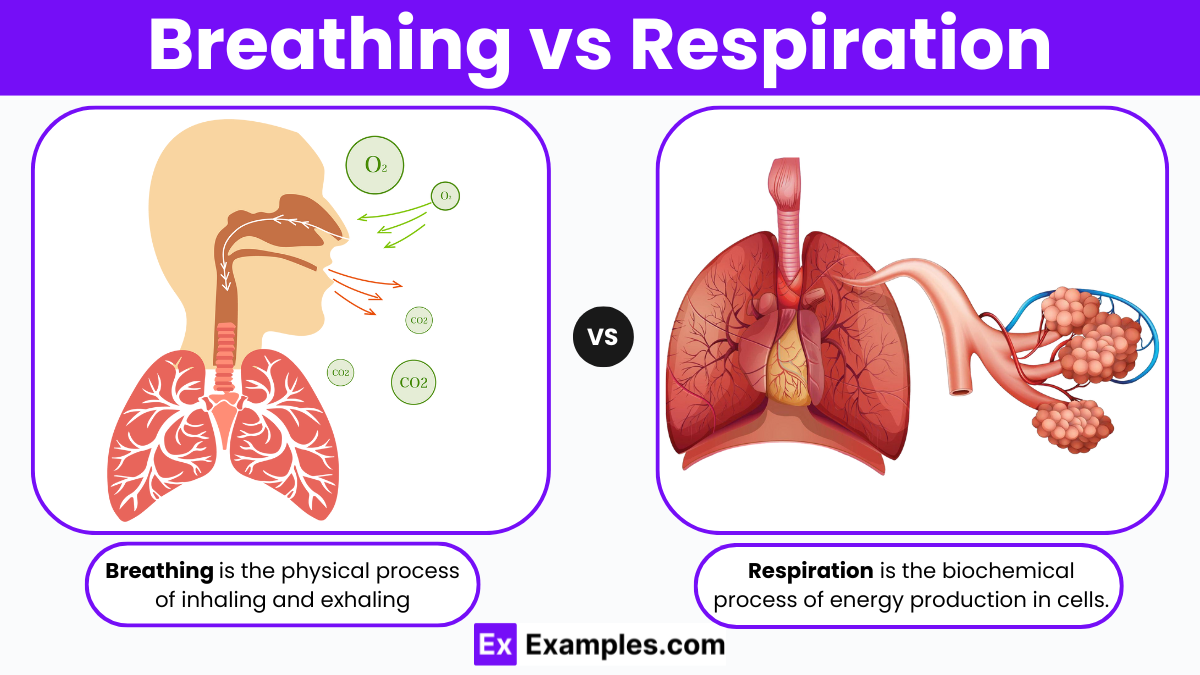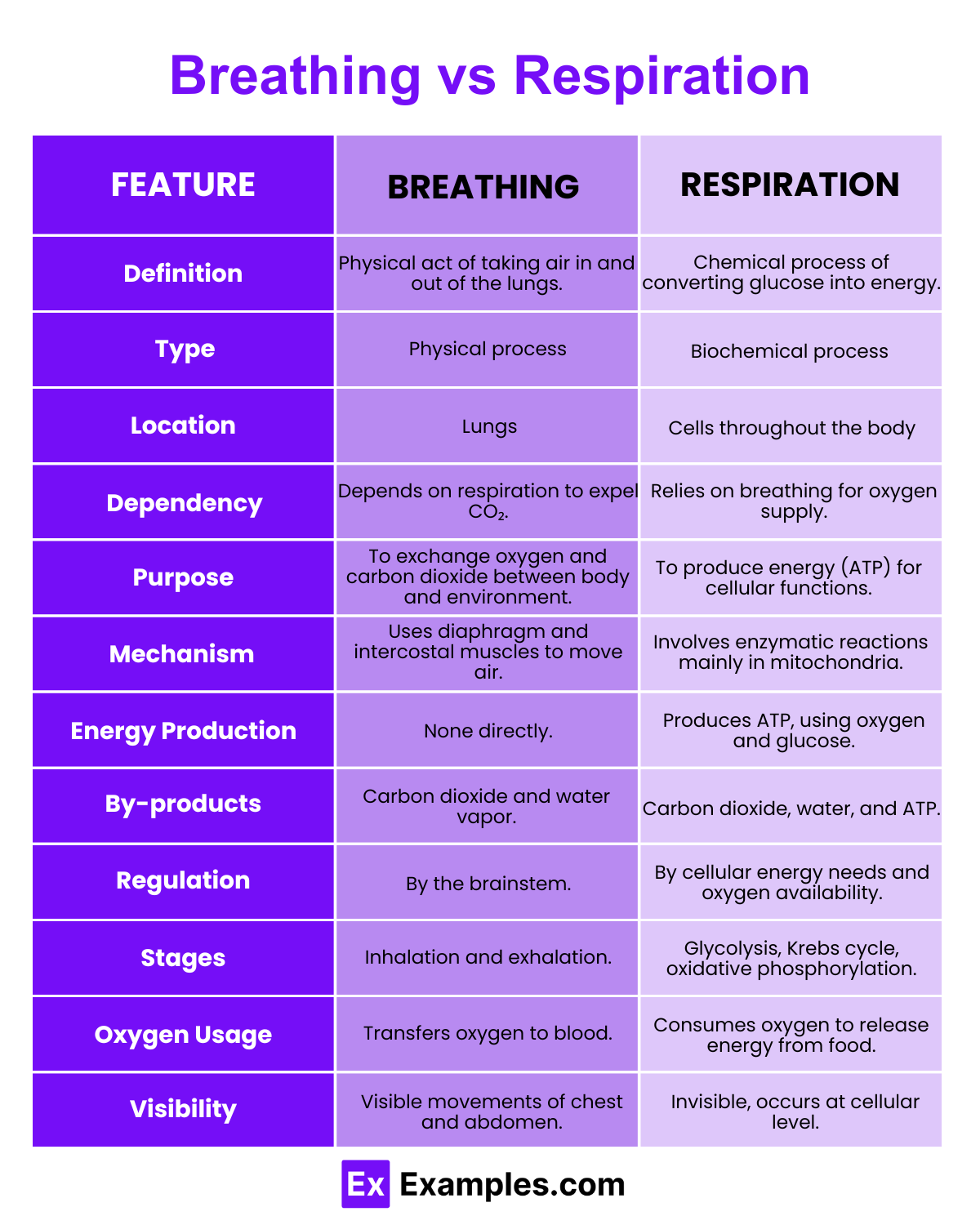Which of the following best describes breathing?
The process of releasing energy from food
The exchange of gases between the body and the environment
The breakdown of glucose in cells
The production of carbon dioxide and water in cells

Breathing and cellular respiration are fundamental processes essential for life, yet they are distinct in function and significance. While often used interchangeably in casual conversation, these terms refer to specific biological activities crucial for the survival of almost all organisms. Cellular respiration is a complex biochemical pathway that allows cells to convert nutrients into energy, a vital process for all cellular functions and overall organism health. In contrast, breathing is a mechanical process involving the inhalation of oxygen and the exhalation of carbon dioxide, primarily through the lungs in humans. This process is critical for maintaining the oxygen and carbon dioxide balance necessary for efficient cellular function and energy production. Understanding the differences between these processes is key to comprehending how living organisms harness and utilize energy to sustain life’s myriad activities.
Breathing involves inhaling oxygen and exhaling carbon dioxide. It is a mechanical process that moves air into and out of the lungs through the respiratory tract. This process is crucial for adding oxygen to the blood and removing carbon dioxide, a waste product from cellular metabolism. The diaphragm and intercostal muscles drive this process by expanding and contracting the lungs.
Consider a person running on a track. As they run, their breathing rate increases dramatically. They inhale more oxygen and exhale more carbon dioxide rapidly. This increase in breathing ensures that enough oxygen is available to meet the heightened energy demands of their muscles.
Inside the cells of the runner’s muscles, respiration ramps up to match the increased oxygen supply. Oxygen reacts with glucose in the cells’ mitochondria, producing energy in the form of ATP (adenosine triphosphate). This energy fuels the muscle contractions required for running, demonstrating the critical role of cellular respiration in energy production.

| Aspect | Breathing | Respiration |
|---|---|---|
| Definition | Breathing is the physical process of taking air into the lungs and then expelling it out. | Respiration is a biochemical process that involves the breakdown of glucose to produce energy (ATP). |
| Type of Process | Mechanical | Biochemical |
| Occurs In | Lungs | Cells throughout the body |
| Purpose | To facilitate the exchange of oxygen and carbon dioxide between the atmosphere and the body. | To produce energy necessary for all life processes. |
| Mechanism | Involves the movement of the diaphragm and rib cage to create negative pressure that draws air into lungs. | Includes glycolysis, the Krebs cycle, and the electron transport chain, occurring in mitochondria (in eukaryotes). |
| Involvement of Organs | Mainly the lungs, nasal cavity, trachea, and bronchi. | All cells, particularly involves mitochondria for aerobic respiration. |
| Gas Exchange | Direct exchange of gases (Oxygen in, Carbon dioxide out) in the lungs. | Utilizes oxygen to breakdown glucose and produces carbon dioxide as a waste product. |
| Energy Release | Does not involve release or production of energy. | Directly involved in the production of ATP (Adenosine Triphosphate). |
| Breathing Types | Includes voluntary and involuntary breathing controlled by the respiratory center in the brain. | Does not apply. |
| End Products | None directly (only exchange of gases). | Energy (ATP), water, and carbon dioxide. |
| Dependency | Can be controlled voluntarily (e.g., holding breath) and works automatically (involuntary). | Continuous and involuntary, necessary for cell survival and function. |
| Chemical Reactions | None | Involves complex chemical reactions including oxidation and reduction. |
| Control Systems | Controlled by the respiratory center in the brainstem, which regulates the rate and depth of breathing. | Controlled at the cellular level by enzymes and availability of substrates. |
| Response to Exercise | Increases in rate and depth to meet higher oxygen demand and carbon dioxide removal. | Increases in rate to meet energy demands, leading to more rapid glucose breakdown and ATP production. |
| Physiological Changes | Changes include increase in breathing rate and tidal volume. | Cellular respiration rates adjust based on energy demand and oxygen availability. |
| Hormonal Influence | Generally not influenced directly by hormones. | Hormones like adrenaline can increase respiration rate by enhancing metabolism. |
| Health Implications | Disorders include asthma, COPD, and bronchitis affecting breathing mechanics. | Disorders such as mitochondrial diseases affect cellular respiration efficiency. |
Despite their differences, breathing and respiration share several key similarities:
Respiration is a chemical process producing energy at the cellular level, while breathing is the physical act of inhaling and exhaling air.
Breathing in, or inhaling, refers to drawing air into the lungs, a crucial step in the breathing process.
Breathing provides oxygen for respiration and expels carbon dioxide, linking these essential life-sustaining processes.
No, respiration does not mean breathing out. It refers to the cellular process that generates energy by using oxygen.
Respiration is the process by which cells generate energy from oxygen and nutrients, releasing carbon dioxide.
Text prompt
Add Tone
10 Examples of Public speaking
20 Examples of Gas lighting
Which of the following best describes breathing?
The process of releasing energy from food
The exchange of gases between the body and the environment
The breakdown of glucose in cells
The production of carbon dioxide and water in cells
Which of the following is a characteristic of respiration but not breathing?
Involves energy production
Requires the lungs
Occurs only in the respiratory system
Exchanges gases with the external environment
What is the main purpose of cellular respiration?
To remove waste from the body
To produce energy for cellular activities
To help with digestion
To exchange gases in the lungs
Where does respiration occur?
Lungs
Cells
Nasal cavity
Trachea
Which process directly produces carbon dioxide as a byproduct?
Breathing
Inhalation
Exhalation
Respiration
What is the primary function of breathing?
To provide oxygen to cells
To produce glucose
To break down food
To convert energy into ATP
How are breathing and respiration related?
Both occur only in the lungs
Breathing supplies oxygen, while respiration uses it to produce energy
Respiration is the physical process, and breathing is the chemical process
Both are identical processes
Which of the following statements is true regarding respiration?
It is the same as breathing
It happens in the lungs
It is a chemical process inside cells
It involves the exchange of air with the environment
What gas is essential for cellular respiration?
Nitrogen
Oxygen
Carbon dioxide
Hydrogen
Which of the following is NOT a result of cellular respiration?
Energy (ATP)
Oxygen
Carbon dioxide
Water
Before you leave, take our quick quiz to enhance your learning!

